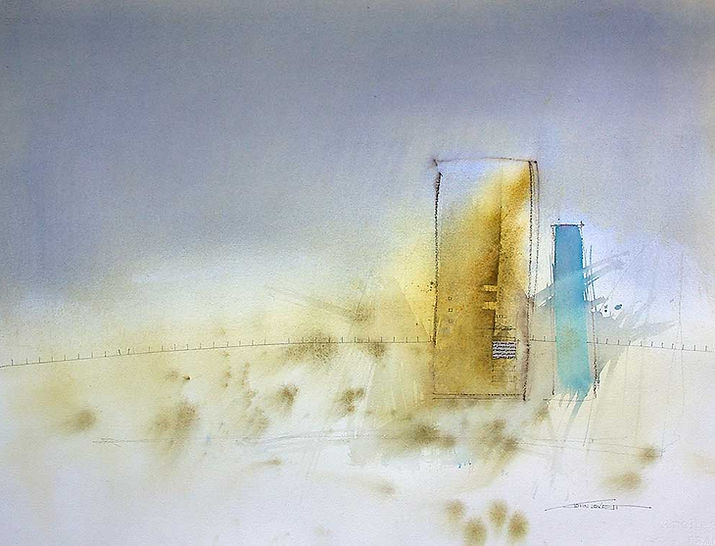
Yellow Watercolor
Yellow is one of those pigments that can make or break a painting. Because it is the highest key, or lightest toned color we use, it has the potential to quickly turn dark mixtures to an opaque muddy sludge.
That’s fine if something heavy and opaque is your intention, but if you are trying to mix a rich clean dark, the choice of yellow is critical. In this article we will examine a number of common yellows and discover the pros and cons of each. The code numbers in brackets after the manufacturers name are the pigments used to produce the color. Not all manufacturers use the same formula for similar colors.

Gamboge
M. Graham & Co. (PY151,PO62) Winsor & Newton (PY150, PR209) A warm orange/yellow with good light fastness. It is a little more sedimentary than most of the Quinacridone Golds or Indian Yellows.
Quinacridone Gold
Holbein (PO48, PY150) Winsor & Newton ( PR206,PV19,PY150) Both of these are extremely transparent, non sedimentary and light-fast. Quinacridone Gold is a compound brownish yellow when concentrated but becomes more yellow as it is diluted. Makes rich, transparent darks without lifting the mixtures tone.
Indian Yellow
Rowney (PY153) Winsor & Newton (PO62, PY139) Similar properties to Quinacridone Gold, but a more saturated yellow/orange. Used to be a fugitive color, but modern pigments have overcome this problem.
Aureolin
Art Spectrum (PY40) Winsor & Newton (PY40) A very transparent slightly staining pigment leaning more towards green than orange. Good for transparent glazes but not quiet as permanent as the Azo Yellows (PY151) which are a more light-fast replacement.
Cadmium Yellow Deep
Art Spectrum (PO20) Winsor & Newton (PY35,PR108) A warm, opaque yellow leaning towards orange. Good for solid opaque marks of saturated, warm yellow. Too high key and sedimentary for mixing darks. High light-fast rating. Makes interesting glazes when dilute.
Raw Sienna
Winsor & Newton (PR42, PY101) A compound yellow with a history going back to the 1600’s. A semi opaque pigment not suited to mixing due to its high key and sedimentary nature. It will lift the tone of dark mixtures. Raw Sienna is often used as a pale under glaze to break up sizing and warm a paper prior to doing a painting.
Yellow Ochre
Winsor & Newton (PY43 - Synthetic Iron Oxide) Art Spectrum (PY42 - Iron Oxide) A compound yellow similar to Raw Sienna, but more opaque and sedimentary.

These three color swatches show the effect of sedimentary and transparent yellow watercolors when mixing darks. A dark made from Permanent Alizarin Crimson and French Ultramarine had, in the first example, Indian yellow added. In the second example, Quinacridone gold and in the third example, Cadmium Yellow. The first two mixtures show clean, rich darks. The third example is muddy, opaque and nowhere near as dark due to the sedimentary opacity of the Cadmium Yellow. My favourite yellow watercolor is Rowney Indian Yellow or W&N Quinacridone Gold - either one makes beautiful rich, transparent darks and they are both vibrant yellows when a reasonably saturated yellow is needed.

Winsor & Newton no longer make Quinacridone Gold. It has now been replaced by Transparent Yellow.
It is very similar to the old Quinacridone Gold with with excellent specifications - my new favourite Yellow
SKU:50694907
Colour Number: 53
Lightfastness: Excellent
Opacity: Transparent
Series:1
Pigment Code:PY150
Granulation/staining: Staining
Permanence: Permanent

This machine was painted using Quinacridone Gold for all the yellows and also as a mix for the dark areas. The yellows were kept interesting by varying the intensity and also by the addition of Permanent Alizarin Crimson to slightly shift the color.

I did this painting using Quinacridone Gold for the darks and yellow under washes. After the painting was dry a final glaze of diluted Cadmium Yellow was used to link the red awning and the blue striped blind. It always amazes me how such an opaque color can become so strong and transparent in dilution.

Sometimes a strong hit of opaque yellow is required to hold attention in a focal point. This is where pure Cadmium Yellow comes into it own. Most of this painting used Indian Yellow for washes and darks, but to get that solid intensity, Cadmium works almost like yellow gouache.

The only yellow used in this painting was Yellow Ochre applied to wet paper. I was after a dirty, grainy, subdued yellow in keeping with the muted colors and textures of the desert country.
Even if you don't use pure, saturated yellows in your paintings it helps to know the pigment qualities of the yellow watercolors you use as they have a big impact on the clarity of your work.
Author: John Lovett